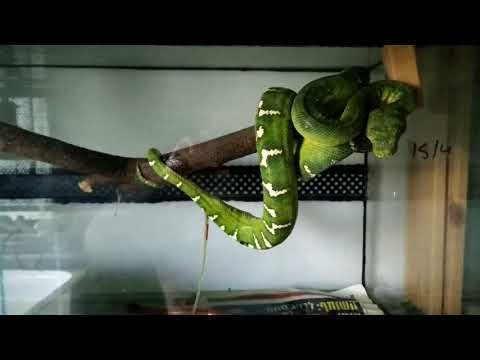Emerald tree boas and green tree pythons are two species of snakes that share a remarkable resemblance in their appearance and behavior. They are both brightly colored, arboreal, and non-venomous constrictors that hunt mostly at night. However, despite their similarities, they belong to different families of snakes and have several distinct features that set them apart. In this article, we will explore some of the main differences between emerald tree boas and green tree pythons, and how they affect their care, patterns, scales, head shape, heat pits, natural locations, behaviors, and reproduction.
Overview of Both Species
Emerald tree boas (Corallus caninus) are members of the Boidae family, which includes other boas and anacondas. They are native to the rainforests of South America, where they inhabit the canopy layer of the forest. They can grow up to 6 feet (1.8 meters) in length and weigh up to 4 pounds (1.8 kilograms). They have a vivid green coloration with white or yellow zigzag stripes along their back. Their belly is yellowish and some individuals may have blue or green spots on their body. Juveniles are usually bright red or orange before they change to green as they mature.
Green tree pythons (Morelia viridis) are members of the Pythonidae family, which includes other pythons and blood pythons. They are native to New Guinea, some islands in Indonesia, and the Cape York Peninsula in Australia. They prefer tropical rainforests with high humidity and vegetation. They can reach up to 7 feet (2.1 meters) in length and weigh up to 3.5 pounds (1.6 kilograms). They have a bright green coloration with gold or yellow markings on their body. Their belly is white or cream-colored and some individuals may have blue or black spots on their body. Juveniles are usually yellow or red before they change to green as they mature.
Different Care Requirements
Both emerald tree boas and green tree pythons require similar care conditions in captivity, but there are some differences that need to be considered. Both snakes need a large enclosure with plenty of branches, plants, and hiding places to mimic their natural habitat. They also need a temperature gradient of 75-85°F (24-29°C) during the day and 70-75°F (21-24°C) at night, with a basking spot of 90-95°F (32-35°C). They also need high humidity of 70-80% to prevent dehydration and shedding problems.
However, emerald tree boas are more sensitive to stress and handling than green tree pythons. They may bite or hiss if disturbed or threatened, and they may refuse to eat if stressed. Therefore, they need more privacy and less handling than green tree pythons. Green tree pythons are generally more docile and tolerant of handling than emerald tree boas, but they still need to be handled gently and infrequently to avoid stress.
Both snakes feed mainly on rodents, such as mice and rats, but they may also eat birds, lizards, frogs, or bats in the wild. They should be fed once every 7-10 days for adults and once every 5-7 days for juveniles. They should be offered prey items no larger than the widest part of their body to avoid choking or regurgitation.
Different Patterns
One of the most obvious differences between emerald tree boas and green tree pythons is their pattern. Emerald tree boas have white or yellow irregular stripes along their back that resemble lightning bolts. These stripes may vary in width, shape, and number depending on the individual snake. Some emerald tree boas may have no stripes at all, while others may have many stripes that cover most of their body.
Green tree pythons have gold or yellow markings on their body that may form spots, blotches, diamonds, or ovals depending on the individual snake. These markings may vary in size, shape, and number depending on the snake’s origin and genetics. Some green tree pythons may have no markings at all, while others may have many markings that cover most of their body.
Both snakes use their patterns to camouflage themselves among the leaves and branches of the rainforest canopy. Their patterns also help them attract mates during the breeding season.
Different Scales
Another difference between emerald tree boas and green tree pythons is their scale structure. Emerald tree boas have irregular scales on their head that vary in size and shape depending on the individual snake. Some emerald tree boas may have large scales on their head that resemble horns or ridges, while others may have small scales that are smooth and flat. Emerald tree boas also have keeled scales on their body, which means that they have a raised ridge along the center of each scale. This gives them a rough and textured appearance.
Green tree pythons have symmetrical scales on their head that are uniform in size and shape. They have a single row of large scales along the top of their head that are separated by small scales. They also have smooth scales on their body, which means that they have no ridge or keel on each scale. This gives them a sleek and glossy appearance.
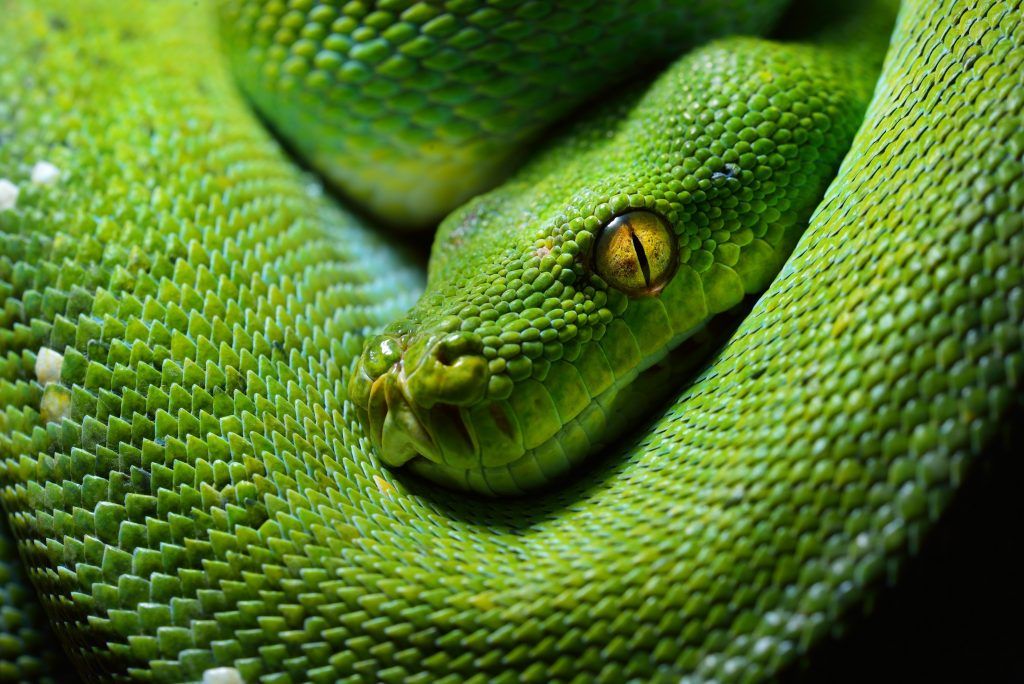
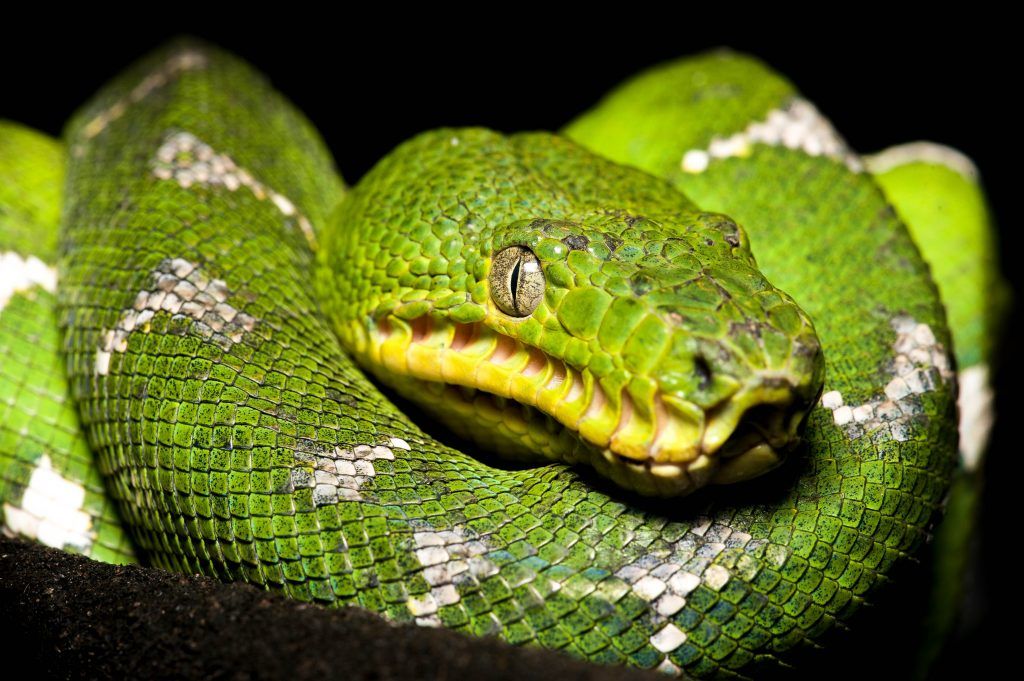
Both snakes use their scales to protect themselves from predators and parasites. Their scales also help them regulate their body temperature and moisture levels.
Different Head Shape
Another difference between emerald tree boas and green tree pythons is their head shape. Emerald tree boas have diamond-shaped heads with a pointed snout and a narrow neck. Their eyes are large and round, and their pupils are vertical. Their mouth is wide and curved, and their teeth are long and sharp.
Green tree pythons have triangular-shaped heads with a rounded snout and a thick neck. Their eyes are small and oval. Their mouth is narrow and straight, and their teeth are short and sharp.
Both snakes use their head shape to adapt to their arboreal lifestyle. Their head shape helps them grip onto branches, strike at prey, and swallow large food items.
Different Heat Pits
Another difference between emerald tree boas and green tree pythons is their heat pits. Heat pits are special organs that allow snakes to sense the infrared radiation emitted by warm-blooded animals. Heat pits are located on the upper and lower lips of the snake, and they look like small holes or dimples.
Emerald tree boas have heat pits on both the upper and lower lips, but they are more prominent on the lower lip. They have about 20-25 heat pits on each side of the mouth, which are arranged in two rows.
Green tree pythons have heat pits only on the lower lip, and they are less noticeable than those of emerald tree boas. They have about 10-15 heat pits on each side of the mouth, which are arranged in a single row.
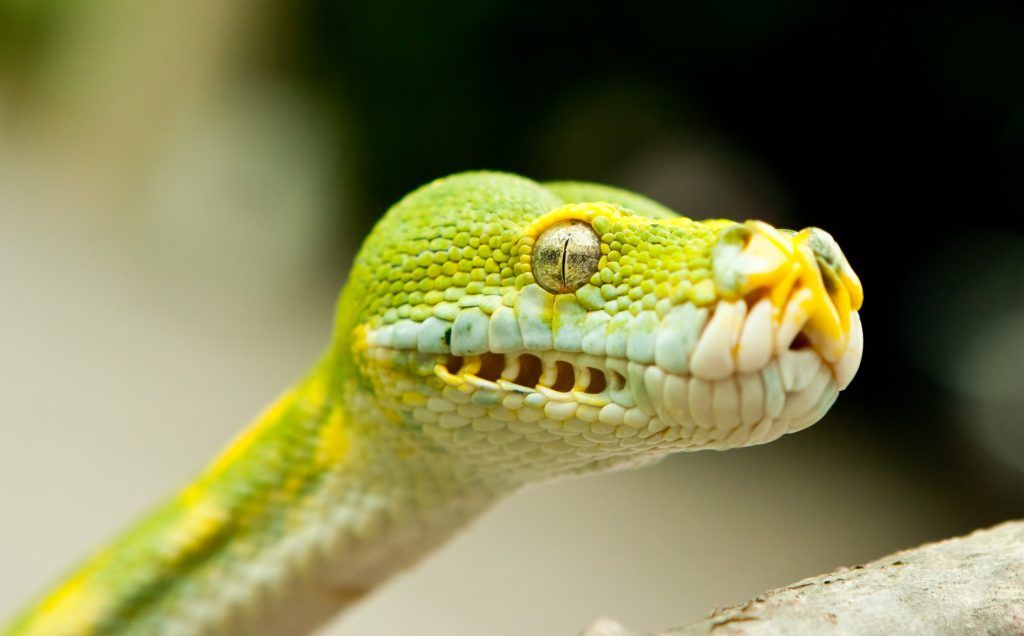
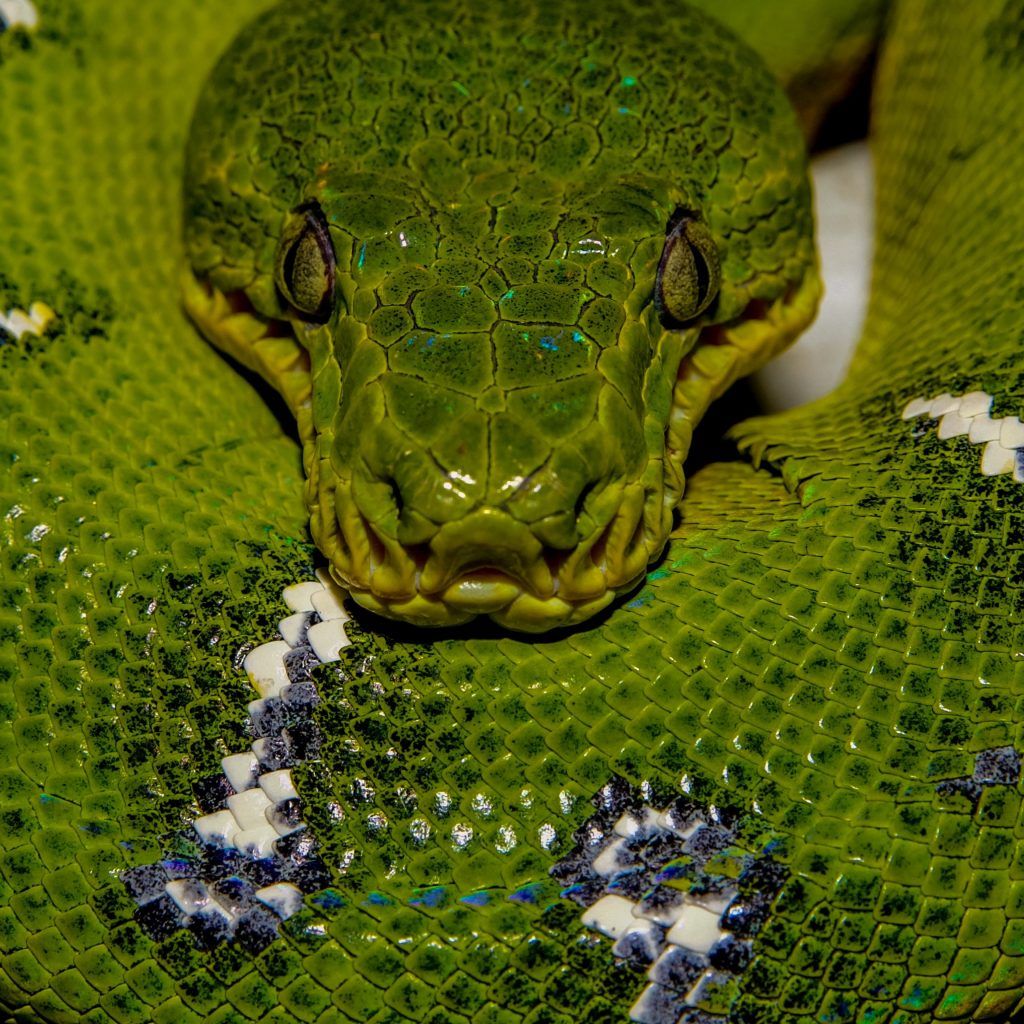
Notice the heat pits of the green tree python on the left vs. the emerald tree boa on the right.
Different Natural Locations
Another difference between emerald tree boas and green tree pythons is their natural locations. Emerald tree boas are native to South America, where they inhabit the rainforests of Brazil, Peru, Ecuador, Venezuela, Colombia, French Guiana, Suriname, Guyana, and Bolivia. They may also be found in secondary forests and gardens near human settlements.
Green tree pythons are native to New Guinea, some islands in Indonesia, and the Cape York Peninsula in Australia. They prefer tropical rainforests with high humidity and vegetation. They may also be found in mangroves, savannas, woodlands, and plantations near human settlements.
Both snakes face threats from habitat loss, deforestation, poaching, and illegal trade. However, they are not considered endangered or threatened by the IUCN Red List of Threatened Species. They are listed as least concern due to their wide distribution and adaptability.
Behaviors
Another difference between emerald tree boas and green tree pythons is their behavior. Both snakes are nocturnal (active at night) and arboreal (living in trees), but they have some differences in their activity patterns, hunting strategies and social interactions.
Emerald tree boas are more active during the dusk and dawn hours, while green tree pythons are more active during the middle of the night. Both snakes spend most of their time coiled around branches in an S-shaped posture, waiting for prey to come within striking distance. However, emerald tree boas tend to move more frequently than green tree pythons, and they may change their position or location several times during the night. Green tree pythons tend to stay in the same spot for long periods of time (up to 2 weeks), and they may only move when they need to shed, drink, or mate.
Both snakes hunt by using their heat pits and their vision to locate warm-blooded animals, such as rodents, birds, or bats. They strike quickly and wrap their coils around their prey, suffocating them to death. However, emerald tree boas tend to be more aggressive and opportunistic than green tree pythons, and they may attack larger or more dangerous prey than they can handle. Green tree pythons tend to be more cautious and selective than emerald tree boas, and they may avoid prey that are too big or too risky for them.
Both snakes are solitary and territorial, and they may defend their space from intruders of the same or different species. However, emerald tree boas tend to be more hostile and intolerant than green tree pythons, and they may fight or bite any snake that comes near them. Green tree pythons tend to be more tolerant and peaceful than emerald tree boas, and they may coexist or share branches with other snakes of the same or different species.
Reproductive Differences
Another difference between emerald tree boas and green tree pythons is their reproduction. Both snakes breed seasonally, usually in the spring or summer months. However, emerald tree boas give birth to live young (viviparous), while green tree pythons lay eggs (oviparous).
Emerald tree boas mate in the trees, where the male wraps his tail around the female’s body and inserts his hemipenes (paired reproductive organs) into her cloaca (common opening for excretion and reproduction). The gestation period lasts for about 6-8 months, during which the female may eat less or stop eating altogether. The female gives birth to 6-14 offspring per litter, each measuring about 18 inches (45 centimeters) in length. The newborns are bright red or orange in color, and they change to green as they grow older.
Green tree pythons mate on the ground, where the male coils his body around the female’s body and inserts his hemipenes into her cloaca. The incubation period lasts for about 2-3 months, during which the female may eat normally or reduce her food intake. The female lays 6-30 eggs per clutch, each measuring about 2 inches (5 centimeters) in length. The female coils her body around the eggs to protect them and regulate their temperature and humidity. The hatchlings emerge from the eggs after about 50 days, each measuring about 12 inches (30 centimeters) in length. The hatchlings are yellow or red in color, and they change to green as they grow older.
Difference Between Boas and Pythons
Emerald tree boas and green tree pythons belong to different families of snakes: Boidae and Pythonidae respectively. Although they share some characteristics as constrictors, there are some general differences between boas and pythons that apply to these two species as well.
One difference is their reproductive mode. Boas give birth to live young (viviparous), while pythons lay eggs (oviparous). Emerald tree boas can produce 6-14 offspring per litter, while green tree pythons can lay 6-30 eggs per clutch.
Another difference is their skull structure. Boas have fewer bones in their skull than pythons, and they lack a premaxilla bone in the upper jaw. This means that boas have fewer teeth than pythons as well. Emerald tree boas have about 100 teeth, while green tree pythons have about 140.
A third difference is their evolutionary history. Boas are considered more primitive than pythons because they have not changed much during the millions of years they have been around. Pythons are considered more derived than boas because they have evolved more features. Emerald tree boas and green tree pythons are examples of convergent evolution: when two unrelated species develop similar traits due to similar environmental pressures.
Conclusion
Emerald tree boas and green tree pythons are two fascinating species of snakes that have many similarities and differences in their appearance and behavior. They are both beautiful, exotic, and captivating creatures that deserve respect and admiration. They are also challenging pets that require special care and attention from experienced keepers who can provide them with suitable conditions and needs. By learning more about these snakes, we can appreciate their diversity and uniqueness in the natural world.

